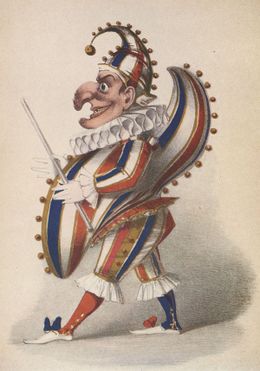Annotation:Punchinello (1): Difference between revisions
No edit summary |
No edit summary |
||
| (7 intermediate revisions by 2 users not shown) | |||
| Line 1: | Line 1: | ||
---------- | |||
---- | {{TuneAnnotation | ||
|f_tune_annotation_title= https://tunearch.org/wiki/Annotation:Punchinello_(1) > | |||
'''PUNCHINELLO [1].''' AKA – “Punchinello’s Hornpipe.” AKA and see “[[Jock and Tam]],” “[[Lady Susan Montgomery's Hornpipe]],” “[[Rusty Gulley (2)]],” “[[Three Case Knives]],” “[[Three Rusty Swords]].” English, Triple or “Old” Hornpipe (3/2 time). G Minor. Standard tuning (fiddle). AABB (Callaghan): AABBCC (Howe). | |f_annotation=[[File:punch2.jpg|260px|thumb|left|Punch, mid-19th century. "The comic character of Punch takes many forms but most have some of the following characteristics: short stature, large belly, hooked nose, jutting chin, prominent hunchback, a ferocious temper and squeaking voice. His distinctive costume will often feature a tall, conical hat, an oversized ruff, large buttons down his striped front and carrying a wooden slapstick" [http://www.libraryofbirmingham.com/punchandjudy?nojs#].]]'''PUNCHINELLO [1].''' AKA – “Punchinello’s Hornpipe.” AKA and see "[[Flat Cap]]," “[[Jock and Tam]],” “[[Lady Susan Montgomery's Hornpipe]],” "[[Knives and Forks]]," “[[Rusty Gulley (2)]],” “[[Three Case Knives]],” “[[Three Rusty Swords]]," "[[Wee Totum Fogg]].” English, Triple or “Old” Hornpipe (3/2 time). G Minor. Standard tuning (fiddle). AB (Offord): AABB (Callaghan): AABBCC (Howe). “Punchinello’s Hornpipe, or Three Rusty Swords” appears in John Offord’s late 20th century publication '''John of the Greeny Cheshire Way''', another setting of which appears in the same volume as “Three Case Knives.” Punchinello, shortened to Punch, was a favorite puppet character for a few centuries. The name Punchinello is a variant of the names Pulcinella, Polichinello, Pollicinella and Polichinelle, and derived from the Italian ''pulcino'', a chicken, which refers to the character’s beak-like nose and his chirpy voice. On the comic stage he was a servant, like the character Harlequin, in the Commedia dell’arte. | ||
<br> | <br> | ||
<br> | <br> | ||
| Line 9: | Line 8: | ||
<br> | <br> | ||
<br> | <br> | ||
See also Edinburgh fiddler and writing master David Young's versions of the tune under the titles “[[Jock and Tam]]" and “[[Lady Susan Montgomery's Hornpipe]].” | |||
|f_source_for_notated_version= | |||
' | |f_printed_sources=Callaghan ('''Hardcore English'''), 2007; p. 77. Offord ('''John of the Green: Ye Cheshire Way'''), 1985; p. 67. | ||
|f_recorded_sources= | |||
|f_see_also_listing= | |||
}} | |||
------------- | |||
'' | |||
---- | |||
Latest revision as of 21:00, 24 September 2023
X:1 T:Punchenella's Hornpipe T:Punchinello [1] R:three-two M:3/2 L:1/8 F:http://music.gordfisch.net/montrealsession/assets/abc/threetwo.abc K:Gmaj |:G/A/B/c/ dG BG|FA Ac BA|G/A/B/c/ dG BG|DG GB AG:| |:g2 f2 eg|fd df ed|ce Bd Ac|BG GB AG:|

The melody is similar to "Dusty Miller (6).”
See also Edinburgh fiddler and writing master David Young's versions of the tune under the titles “Jock and Tam" and “Lady Susan Montgomery's Hornpipe.”

